The retention centre in Blackboard contains a number of preset rules. This guide shows how to adjust those rules and set up new ones.
Access Retention Centre
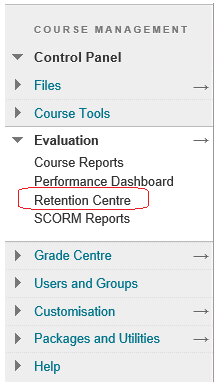
1. To enter the Retention Centre access the Blackboard course concerned and expand the Evaluation part of the Control Panel and choose Retention Centre.
Customise
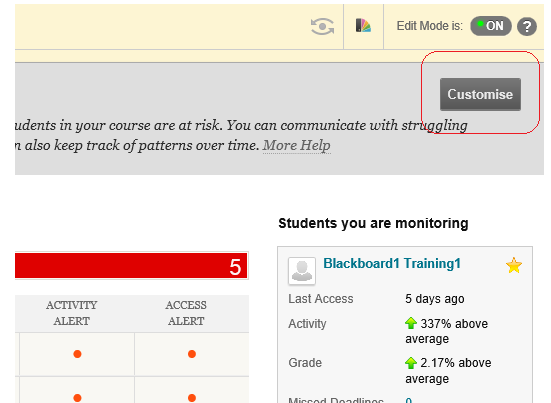
2. Click on the Customise button. This appears at the top right of the Retention Centre screen.
The Customise Retention Centre screen
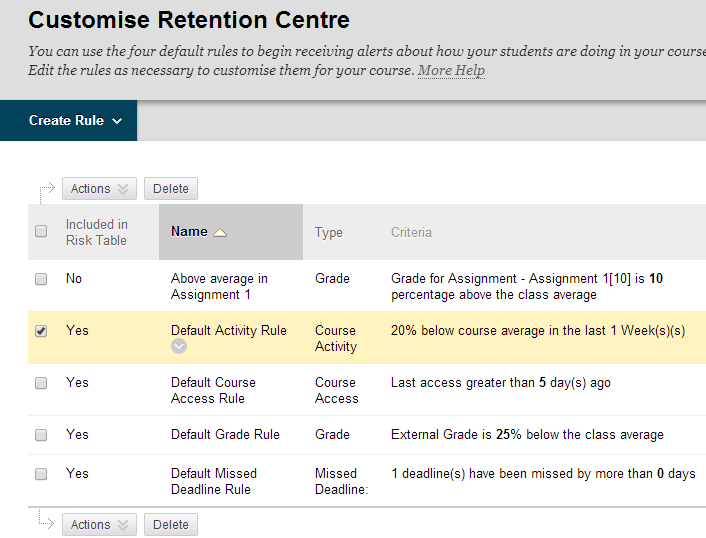
3. The Customise Retention Centre screen is shown. Here follows a break down of the interface.
Create Rule
Click on this button to create a new rule.
The rest of the interface details all existing rules:
Included in Risk Table
Yes: this rule is included in the risk table shown on the main Retention Centre screen. In this screen there will always be four columns, one for each of the rule types, i.e Grade, Course Activity, Course Access, and Missed Deadline. If there is than one rule for one of the above types included in the risk table then student who matches any of those rules will have an entry under that column.
No: this rule will not be part of the risk table and instead will appear within the Other information you are monitoring section.
Name
The Name of the rule. When you hover your mouse pointer over the name an action button appears. Clicking on this action button will bring up a menu allowing you to edit the existing rule.
Type
The type of rule. There are four rule types available: Grade, Course Activity, Course Access, and Missed Deadline
Criteria
Information about the criteria used to determine whether a student is affected by the rule or not.
Actions: Here you may choose quickly to exclude or include a rule from the rule table by ticking the box beside the rule concerned then clicking on the Action button.
Delete: This will completely remove the rule. Even if all rules of a certain type are deleted e.g. Grade, Course Activity, Course Access, and Missed Deadline, all four columns will continue to be shown in the Risk Table on the main Retention Centre screen.
Editing a rule
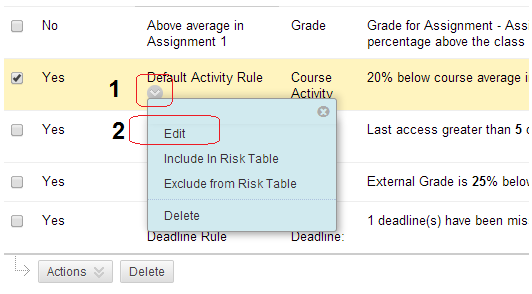
4. Next we will look at editing an existing rule. To edit an existing rule hover your mouse over the rule name and click on the Action button. Then click on Edit from the menu that appears.
Example
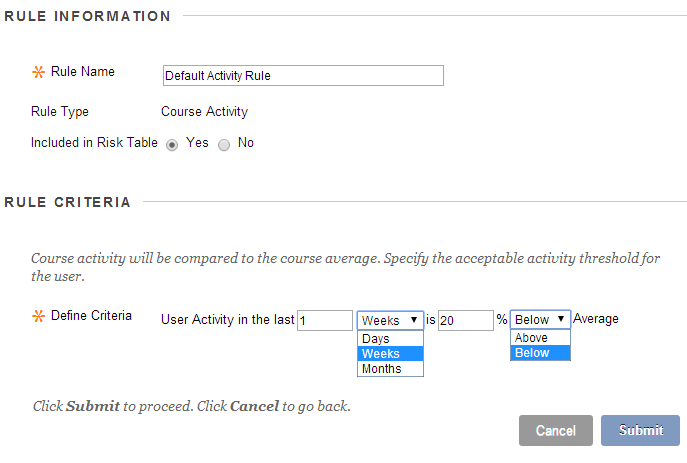
5. Each rule type will have a slightly different set of option but the above screen shot shows how simple it is to use this feature.
Creating a new rule
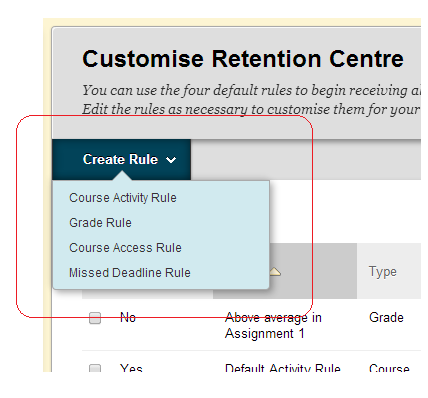
6. Next we look at creating a new rule. To create a new rule hover your mouse over the Create Rule button on the Customise Retention Centre screen and choose which type of rule you wish to create. The next set of slides cover how to create each rule type.
Course activity alerts
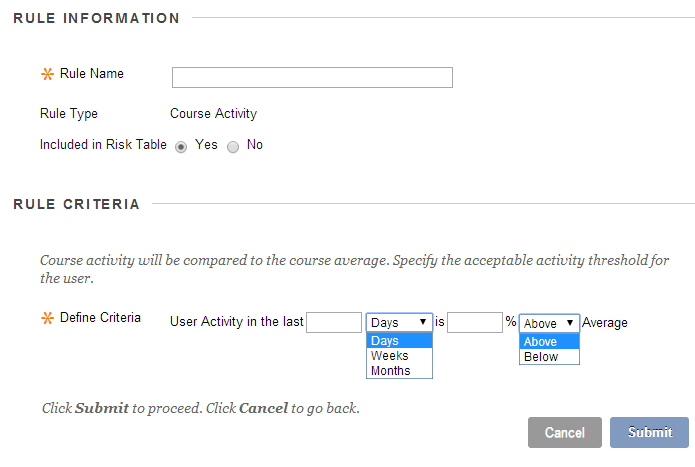
7. Course activity alerts are based on students’ overall activity within your course. Students who are below a defined level of activity trigger the alert.
Blackboard measures the time a student works in a course using the data generated from his “clicks.” A student is assumed to be working with a course from the time he clicks on something in the course until the time he clicks something outside the course or logs out. If a login session is timed out, Blackboard only counts the time until the last click within the course. The time is not counted between the last click within the course and the timeout.
No weighting of clicks is assigned to any areas.
Adaptive rules are not taken into account.
8. Set the criteria according to your preference.
Grade Alerts

9. Grade Alerts are based on a defined score for any grade or calculated column in the Grade Centre. Students who score above or below the defined threshold for a specific grade item trigger an alert.
10. Determine when a grade triggers an alert:
Set Grade Value:
Use the drop-down lists to select above or below -AND- points or percentage. Type a value in the field.
Use Average Grades:
Type the percentage in the field and select above or below the average grade from the drop-down list.
Course Access Rules
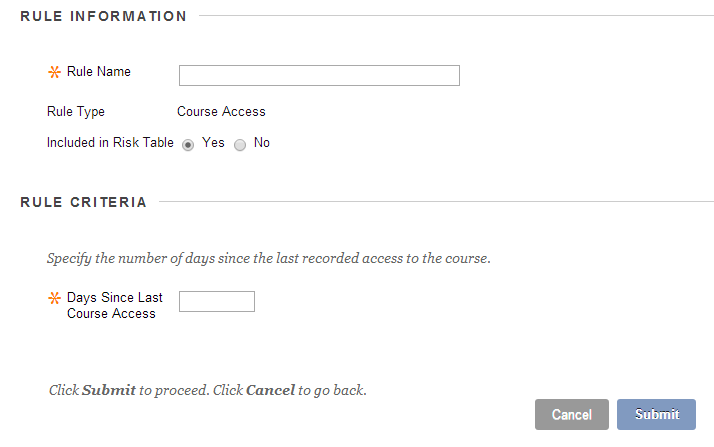
11. Course access rules can be used to set up alerts based on the date users last accessed your course. Students who have not logged in for a defined number of days trigger an alert.
Missed Deadline Rules
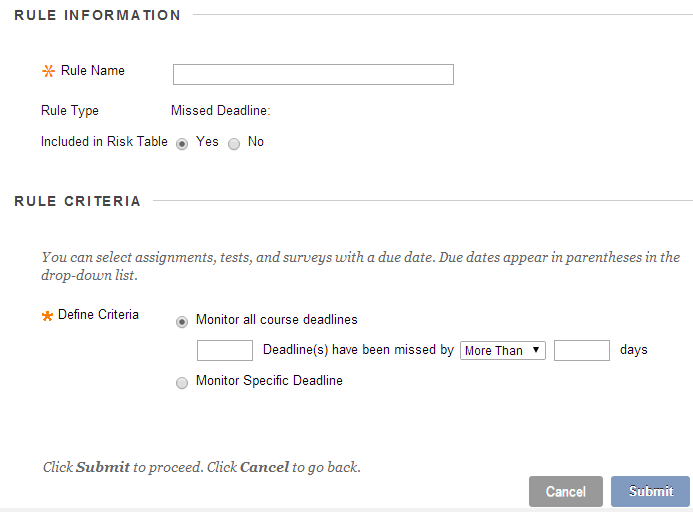
12. Missed Deadline Alerts are based on a defined due date for an assignment, test, or survey. Students who do not complete an assignment, test, or survey by the due date trigger an alert based on the option you choose:
Monitor all course deadlines: Determine how many deadlines must be missed and by how many days before an alert is triggered. From the drop-down list, select More Than or Less Than the number of days you chose.
Monitor Specific Deadline: Make a selection in the Select Course Item drop-down list. The due date for each item appears in parentheses. Then, select More Than or Less Than from the drop-down list and type the number of days to trigger an alert.
If you enter zero (0) for how many days, you are asking to be alerted if an item was not submitted before or on the deadline. No lateness is acceptable.
You can create missed deadline rules for Grade Center columns you create manually, but if you do not mark properly submitted items by the due date, a “false” alert is triggered. For manually created columns, students can submit items by the due date, but you must also grade them by the due date.
In or Out of the Rule Table?
![]()
13. Remember that if you choose to include rules in the risk table then they will be covered within the risk table shown on the main Retention Centre screen. In this screen there will always be four columns, one for each of the rule types, i.e Grade, Course Activity, Course Access, and Missed Deadline. If there is than one rule for one of the above types included in the risk table then student who matches any of those rules will have an entry under that column.
If the rule is not included in the risk table then it will appear within the Other information you are monitoring section.
